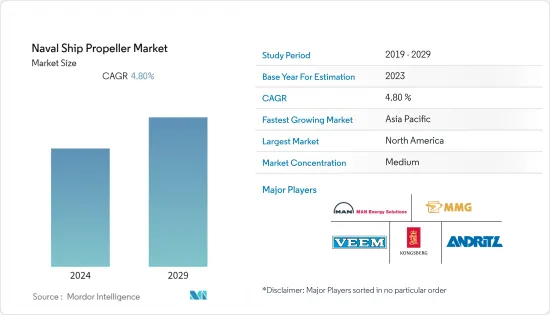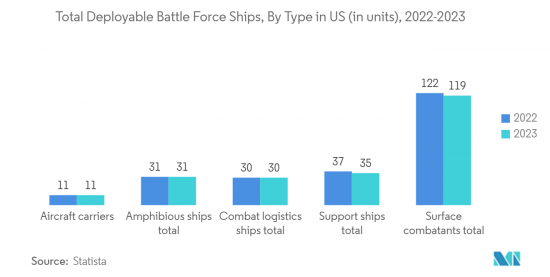
해군 선박용 프로펠러 시장은 2024년에 48억 9,000만 달러로 추정 및 예측되고, 2029년에는 61억 8,000만 달러에 이를 전망이며, 예측 기간(2024-2029년)의 CAGR은 4.8%를 나타낼 것으로 예측됩니다.

조선업계의 전기추진기술에 대한 수요 증가가 해군 선박용 프로펠러 시장을 견인할 것으로 예상됩니다. 이 전기 추진 기술 방식에 의한 추진에서는 클러치나 기어 장치가 불필요하게 됩니다. 이 기술은 기존 시스템에 비해 몇 가지 장점이 있습니다. 기계 부품이 유연하게 배치되므로 높은 중복성, 향상된 이동성, 적재량 증가, 보다 적은 배출 및 연료 소비를 실현합니다.
군이 직면하는 다양한 해양 문제로 인해 해군 선박 조달은 해마다 증가하고 있습니다. 이것은 앞으로 수년간 해군 선박용 프로펠러 시장을 견인할 수 있습니다. 해상 무역 및 안보에 대한 관심 증가도 시장을 강화합니다. 또한, 세계 해군 현대화 계획 증가는 프로펠러 제조 업체에 기회를 제공합니다.
그러나 시장은 생산비용에 영향을 미치는 원재료 가격 변동과 같은 과제에 직면하고 있습니다. 시장은 방위 예산 및 지정 학적 긴장에 크게 좌우됩니다.
고정 피치 프로펠러 부문은 시장에서 가장 높은 점유율을 차지합니다. 고정 피치 프로펠러는 제어 피치 프로펠러와 같은 기계 및 유압 서브 시스템이 내장되어 있지 않기 때문에 견고하고 신뢰할 수 있습니다. 또한 제조, 설치 및 운영 비용이 다른 유형의 프로펠러보다 낮습니다. 따라서 현재는 해군 선박에 널리 사용되고 있습니다. 고정 피치 프로펠러는 소형 선박 및 접근성이 중요한 용도에 적합합니다. 또한 다양한 환경 조건과 운영 요구 사항에서 안정적인 성능을 발휘함으로써 시장에서의 지위는 더욱 견고합니다.

아시아태평양은 예측 기간 동안 가장 높은 CAGR을 나타낼 것으로 예상됩니다. 이 지역의 해군 선박 조달은 인도와 중국과 같은 아시아태평양의 신흥 경제국에 의한 높은 군사비에 의해 추진되고 있습니다. 또한 아라비아해, 인도양, 남중국해에서의 분쟁이 해군의 해상 능력 강화를 뒷받침하고 있습니다.
이 지역 조선업의 성장 및 지정학적 긴장이 함정 수요를 더욱 밀어 올려 프로펠러를 포함한 선진 추진 시스템의 채용을 촉진할 가능성이 있습니다. 이 모든 요인은 함정 조달을 뒷받침하고 해군 선박용 프로펠러 시장의 성장을 지원합니다. 예를 들어, 2022년 8월, BAE Systems Australia는 OEM의 콩스베르그 말리타임 감독하에 호주 헌터급 프리게이트 함을 위한 두 프로토타입 프로펠러 블레이드와 프로펠러 허브를 건설하기 위해 VEEM에 176만 달러의 계약을 체결했습니다. 이것은 VEEM사가 Hunter의 엄격한 기준에 따라 생산하는 능력의 최종 테스트입니다. 이것은 VEEM사가 Hunter 프로그램을 위한 방어 자격을 갖춘 군함 프로펠러 제조업체가 되기 위해 노력하는 중요한 이정표가 됩니다.
해군 선박용 프로펠러 시장은 적당히 통합되어 있으며, 소수의 기업이 시장에서 큰 점유율을 차지하고 있습니다. 현지 기업과 공급망 기업의 인수는 이 시장에서의 존재감을 더욱 높이는 데 도움이 됩니다. 획득하는 계약은 해군 함선이므로 많은 규범과 규제 요건을 충족해야 합니다. 게다가 신규 진입기업에 있어서는 해군 선박용 프로펠러의 크기 및 복잡성이 소형 보트용 프로펠러에 비해 훨씬 높기 때문에 투자비용이 높아질 것으로 예상됩니다. 재료와 디자인 측면에서 연구개발에 대한 투자는 앞으로 몇 년동안 기업을 도울 수 있습니다.

The naval ship propeller market is estimated at USD 4.89 billion in 2024 and is expected to reach USD 6.18 billion by 2029, registering a CAGR of 4.8% during the forecast period (2024-2029).
An increasing demand for electric propulsion technology in the shipbuilding industry is anticipated to drive the naval ship propeller market. This propulsion in electric propulsion technology method eliminates the need for clutches and gearing devices. This technology provides several advantages over the traditional system. Because of the flexible arrangement of mechanical components, it provides high redundancy, enhanced mobility, and increased payload, as well as fewer emissions and fuel consumption.
Procurements of naval ships are increasing every year due to various maritime issues that the military is facing. It may drive the market for naval ship propellers in the years to come. Growing maritime trade and security concerns also bolster the market. Additionally, rising naval modernization programs worldwide create opportunities for propeller manufacturers.
However, the market faces challenges such as fluctuating raw material prices, which impact production costs. The market is majorly dependent on defense budgets and geopolitical tensions.
The fixed-pitch propellers segment holds the highest market share in the market. Fixed pitch propellers are robust and reliable, as the system does not incorporate any mechanical and hydraulic subsystems as in the controlled pitch propellers. Moreover, the manufacturing, installation, and operational costs are lower than the other types of propellers. Thus, they are now widely used in naval ships. The fixed-pitch propellers are well suited for smaller vessels and applications where accessibility is crucial. Furthermore, their consistent performance in various environmental conditions and operational requirements further strengthens their position in the market. For instance, in April 2021, Rolls-Royce reached an agreement with Fincantieri Marinette Marine to design and manufacture up to 40 fixed-pitch propellers for the US Navy's Constellation-class (FFG-62) guided missile frigate program.

Asia-Pacific is expected to register the highest CAGR during the forecast period. Procurements of naval ships in the region are driven by the high military expenditure by the emerging economies in the Asia-Pacific region, such as India and China. Additionally, the disputes in the Arabian Sea, Indian Ocean, and the South China Sea are propelling the navies to further strengthen their sea-based capabilities.
The region's growing shipbuilding industry and geopolitical tensions may further boost the demand for naval vessels, driving the adoption of advanced propulsion systems, including propellers. All these factors are helping the procurement of naval ships, thereby supporting the growth of the naval ship propeller market. For instance, in August 2022, BAE Systems Australia granted a USD 1.76 million contract to VEEM Ltd to construct two prototype propeller blades and a propeller hub for Australia's Hunter class frigates under the supervision of OEM Kongsberg Maritime. It is the final test of VEEM's capacity to manufacture to the Hunter's strict criteria. It represents a critical milestone for VEEM Ltd as it strives to become a defence-qualified warship propeller maker for the Hunter program.
The naval ship propeller market is moderately consolidated in nature, with a presence of few players holding significant shares in the market. Kongsberg Gruppen AS, VEEM Ltd, MAN Energy Solutions SE, Mecklenburger Metallguss GmbH, and ANDRITZ AG are some of the prominent players in the market. Acquisitions of local players and companies in the supply chain help the players further strengthen their presence in the market. As the contracts to be gained are for naval ships, many norms and regulatory requirements should be met. Moreover, for new players, the investment costs are expected to be high, as the size and complexity of the propellers for naval ships are far higher compared to those for smaller boats. Investments in R&D, in terms of materials and designs, may help the players in the years to come.
For instance, in March 2023, Kongsberg Maritime and Hyundai Heavy Industries partnered to supply controllable pitch propellers for the Philippine Navy's future offshore patrol vessels. Under the terms of the agreement, Kongsberg will supply a propellor set for each of Hyundai's six new vessels. Each propellor set comes with two Kamewa 86 A/5 D-B waterjet propulsions, as well as operational panels, shat lines, hydraulic power units, and other accessories. Similarly, in January 2021, Naval Group, a defense contractor, created a fully 3D-printed propeller for a French Navy ship. The propeller, which contains a 2.5 m span and five individual 200 kg blades, is reputedly the largest of its kind to be 3D printed and the first to be created using Naval Group's method.